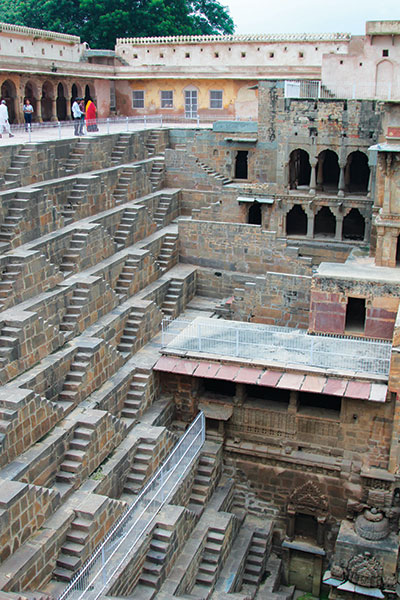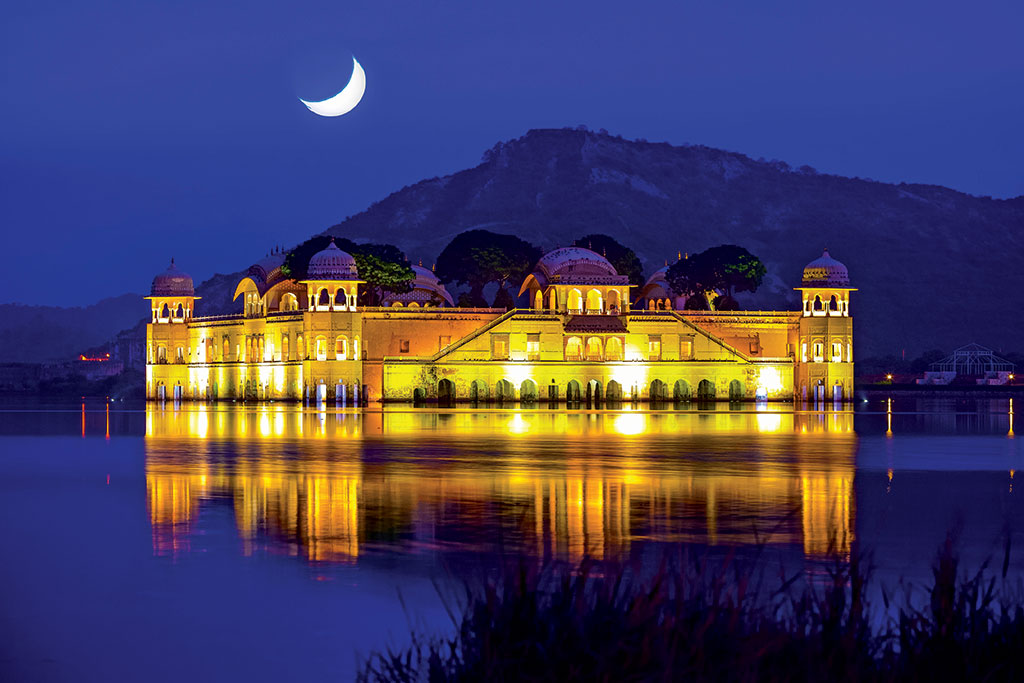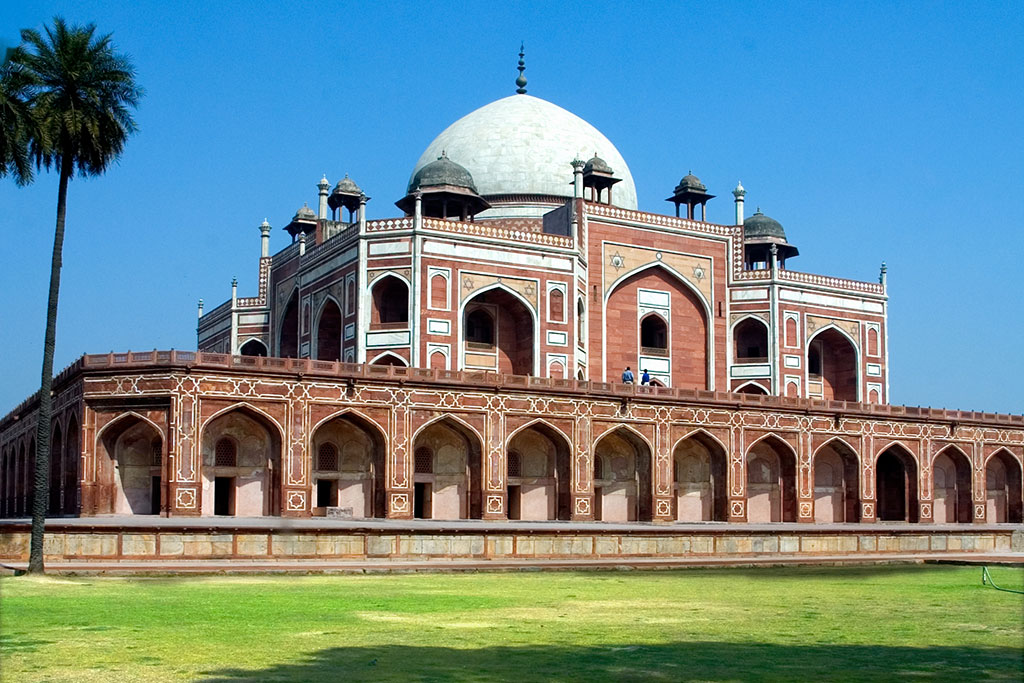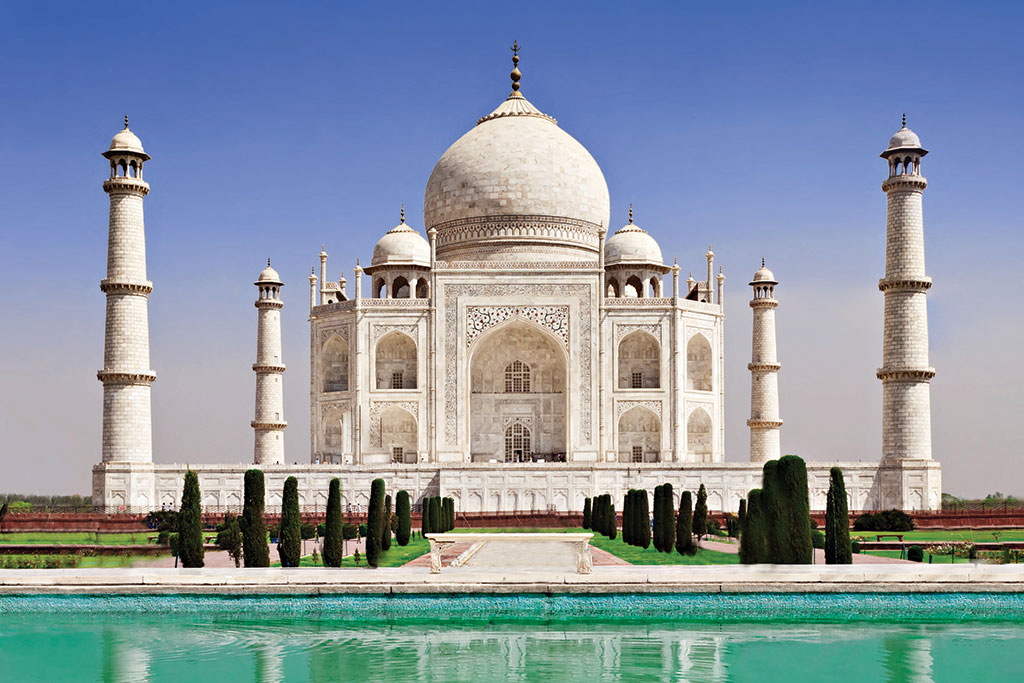At Jaipur Handicrafts (www.jaipurhandicraftsco.in), an irresistible 45,000-square-foot complex of artisans’ studios, galleries, and shopping opportunities, all of the city’s main craft trades are on display under a single roof. Attentive, but not overaggressive salesmen, offered detailed explanations and demonstrations of rug weaving, gemstone cutting and polishing, and marble inlay work.
We were especially impressed with an octogenarian textile printer, who meticulously pressed dye-soaked blocks of carved wood, used like rubber stamps, against large sheets of cotton. Each color in a design requires its own printing block, demanding incredible precision of placement in the creation of complex floral and geometric patterns. Over and over, with near-perfect positioning, guided only by eye, the old man laid down his inks, transforming a plain white sheet into a thing of intricate beauty.

Udaipur City Palace and Lake Pichola
There was no wait at the complex’s impressive bespoke clothing shop, where John and I browsed dozens of fabrics and sample garments before consulting with a patient tailor. He took what seemed like a dozen differ- ent measurements and asked numerous questions in preparing our orders for custom shirts and sport jackets. The gentleman was altogether empathetic when I told him to assume I’d likely be getting fatter, not thinner.
Having never had clothing made-to-measure before, I was concerned about the quality of the finished product, but the fabrics were excellent and the prices, about $40 for a dress shirt, less than $150 for a jacket, were worth a gamble.

Chand Baori
As it turns out, the risk paid off, not only materially (the best fitting sport jacket I’ve ever worn, and a shirt I may mail order in additionally colors) but experientially: having been told our garments would be delivered to our hotel the next evening, John and I were taken aback when, the next afternoon, a Luxe India staff member approached us in the midst of a walking tour of Jaipur’s city palace and hustled us out to the parking lot. Assistants from the tailor shop were waiting outside our group’s tour bus, which we boarded, slipped on our partially made new clothes, and had them marked up for finishing alterations. As in our hotels, the customer service was extraordinary.
Home base for two nights in Jaipur was the Oberoi Rajvilas (www.oberoihotels.com), a compound of spacious villas and a handful of safari-style luxury tents set in a garden surrounding an ancient Hindu temple. We attended an early morning ceremony in the temple, unsure of the exact content being presented by the resident priest, but finding meditative peacefulness in the rituals of repetitive chanting.
Yoga, cooking lessons, and history talks were also on offer at the Oberoi properties we stayed at. One night, impossibly handsome members of the Rajvilas staff, uniformed in multi-colored turbans and block-printed robes, made us traditional headgear of our own. Circling us as we sat on wooden chairs, they twirled and tightened nine-foot bands of richly dyed fabric around our heads.
During our time in Jaipur, our group dined, as we did throughout the majority of the trip, at the hotel. Given the compressed nature of our itinerary, the breakneck pace of our days, and the lurking potential of “Delhi belly” given much of India’s relatively primitive water treatment and sewage facilities, we played it particularly safe (and successfully so).
That said, unlike in the US, hotel restaurants are among the best to be found in India. Luxe India often arranged for our meals to be served family style, allowing each of us to sample a wider range of local specialties. (Luxe’s concierge service has access to tables at trustworthy fine restaurants through- out the country for travelers with the time and stamina to dine out).
Adventurous eaters should know that Indian eateries tend to dial down the heat when serving westerners. So if you like your food spicy, you’ll want to request that the kitchen amp things up to local tastes.

Jal Mahal (Water Palace) in Jaipur
Perhaps the most unexpected tourist attraction we visited while in Jaipur was Jantar Mantar, a UNESCO World Heritage Site. What first appear to be an array of abstract 20th century concrete and marble sculp- tures are a collection of mathematical precise astronomical instruments, dating as far back as 1728. Used to measure the movement of the sun through complex systems of shadowcasting, they generated functional calendars and timekeeping systems. The hybrid of aesthetic beauty and scientifically complex utility on view here is astonishing.
Our most dramatic Jaipur experience, though, was a visit to the Amber Fort, located just outside the city. Constructed beginning in 1592, the beauty of the fortress’ terraced inner courtyards belies the rough-hewn outer walls that protect them.
We were ferried up to the fort on the backs of elephants whose ears and foreheads were decorated with colored chalk designs. As we climbed the zigzag path to the imposing façade, young boys waved and shouted up at us, snapping photographs while urging us to purchase them when we came back down (sure enough, thanks to the kids’ speedy footwork and some hardworking entrepreneurs with digital printers hidden away nearby they had photos ready for us to buy 90 minutes later).
Passing through the fortress’ massive stone gate, we looked over our shoulders at the sweeping green valley below. Looking forward, we saw a courtyard so enormous that dozens of pachyderms and hundreds of tourists didn’t seem like much of a crowd at all. We were swept up in the fantasy grandeur of life in another world.
Fantasy, because needless to say, life in the 16th century was hardly grand for most people living in what is now Northern India. Neither is life today. Not for people (over 20% of the Indian population live on the equivalent of less than $1.25 per day), nor for the Amber Fort elephants. After our return from abroad, we were upset and embarrassed to learn of reports that the over 100 elephants used for tourist transport at the fort have been widely reported to be mistreated and malnourished by their handlers.
There’s no need to deny one’s self a bucketlist trip, a long-dreamed- about skim of another culture’s greatest hits, but due diligence is in order, like bringing an open LGBT presence to countries still evolving in regard to human rights. Also, make sure to let tour operators know that you refuse to participate, and insist that they stop participating, in activities that impinge upon animal rights. Your words and actions will send important signals to foreign governments and businesses.

Humayun’s Tomb, Delhi
As you have the opportunities to make your own dreams come true, it’s worth keeping in mind that there are other realities. In many of them, the quality of life you already lead would surely seem the stuff of fantasy to others.
From Jaipur, we departed by bus toward our final fantasy, the Taj Mahal in the city of Agra. To be honest, after nearly a week chockablock with architectural astonishments, not to mention a lifetime of National Geographic stories, school room posters, and travel brochures, I felt fairly certain the Taj would be a letdown, an Indian equivalent of the Washington Monument or some other over-photographed landmark.
After just about 90 minutes on the road, we took a pit stop that, in and of itself, would have made the day a fantastic success. Relatively untrafficked by foreign tourists, the village of Abhaneri is home to Chand Baori, an Escheresque masterpiece more than 1,000 years old.
From a giant rectangular aperture at ground level, four angled walls sink 13 stories into the ground, forming a sort of hollow, inverted pyramid that long ago served as a village well. Three of the walls are composed of dozens of narrow stone stairways (over 3,500 steps in total), which townspeople once descended to draw springwater from what is now a brackish green pool. Almost surreal in appearance, Chand Baori seems like the set of some unreleased Indiana Jones movie, an inside-out Mayan temple, a structure that should only exist in a dream.
A change in the weather when we resumed our drive to Agra felt more like a nightmare. After a week of almost perfect blue-skied 80 degtree weather, we caught a solid two hours of late-in-the-season monsoon rains. While our steadfast driver nonchalantly powered through waters that lapped against car doors and climbed the front stoops of small town houses, I gritted my teeth and averted my eyes.
The rain cleared almost as suddenly as it had started, and as we pulled into the drive of the Oberoi Amervilas, the only hotel with unobstructed views of the Taj Mahal, we were met by two electric golf carts that immediately ferried us to the monument grounds. Washed clean by the after- noon’s downpour, the soaring marble dome beckoned us to walk toward it through an elegant garden of fountains, perfectly trimmed trees, and a long, narrow reflecting pool.

Taj Mahal
Commissioned by Muslim Emperor Shah Jahan, the Taj is a mausoleum for his beloved wife, Mumtaz Mahal, who died in labor with the couple’s 14th child in 1631. Over 20,000 workers spent more than a decade in the monument’s construction, largely from white marble inlaid with semi-precious stones.
The Taj Mahal did not disappoint. It transcended every photograph I’d ever seen. In part, this was because the near perfect symmetry of the building’s design, from the octagonal chamber at its core to the four free-standing minarets at the corners of its plaza-scaled marble platform, created a remarkable three dimensional space to move through. The flat plane of a picture postcard doesn’t begin to convey the elegant forms and echoing rhythms of a walk within and around the central dome.
Building exponentially on the impact of space and volume was the play of early-evening light on the Taj and its surroundings. As the sun descended, the monument’s backdrop shifted from pale blue to orange, from deep rose to dusky purple; the textures of lattice carvings and calligraphic inlays faded as the buildings flattened into inky silhouettes of their primal geometry.
The Taj Mahal, while it may once have been a bucketlist destination for me, a box to be checked off, was now something different. Transformed by travel, it was no longer a place, but an experience, a set of sensations on their way to becoming memories.


